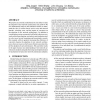Free Online Productivity Tools
i2Speak
i2Symbol
i2OCR
iTex2Img
iWeb2Print
iWeb2Shot
i2Type
iPdf2Split
iPdf2Merge
i2Bopomofo
i2Arabic
i2Style
i2Image
i2PDF
iLatex2Rtf
Sci2ools
CONEXT
2007
ACM
2007
ACM
Modeling the adoption of new network architectures
We propose an economic model based on user utility to study the adoption of new network architectures such as IPv6. We use mathematical analysis and simulation studies to understand the role of various factors such as user and network benefits, switching costs, and the impact of converters on the adoption of new network architectures. In addition to corroborating various commonly held beliefs about new network architecture adoption, our analysis and simulation studies also reveal several surprising and non-intuitive results. For example, while in general, increasing the efficiency of converters hastens the adoption of new network architectures, there are cases in which more efficient converters hinder the adoption of such architectures. This and other results in the paper increase our understanding of new network architecture adoption and guide the design and implementation of mechanisms to hasten new network architecture adoption.
Computer Networks | CONEXT 2007 | Network Architecture Adoption | Network Benefits | Simulation Studies |
| Added | 14 Aug 2010 |
| Updated | 14 Aug 2010 |
| Type | Conference |
| Year | 2007 |
| Where | CONEXT |
| Authors | Dilip Antony Joseph, Nikhil Shetty, John Chuang, Ion Stoica |
Comments (0)

